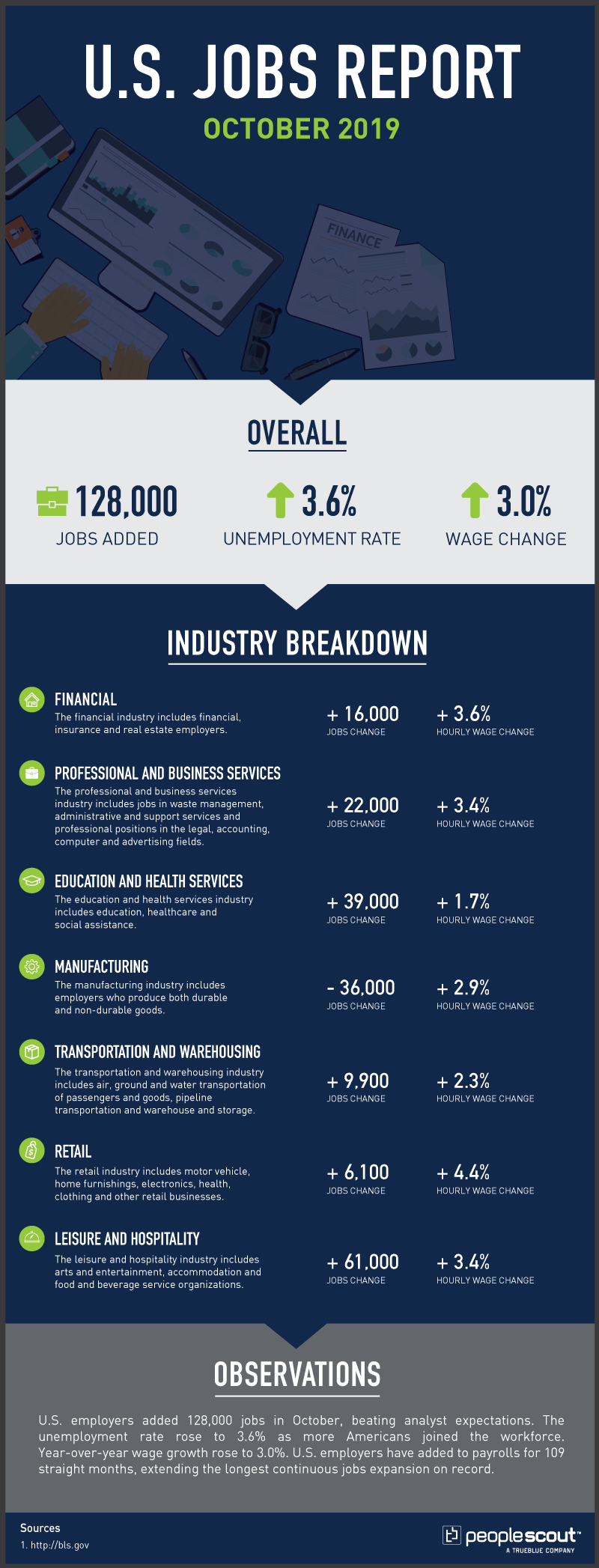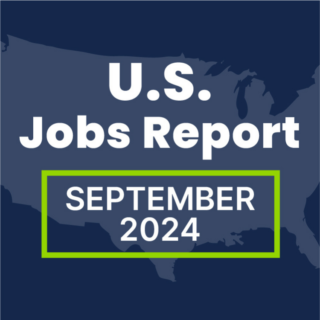The Labor Department released its October Jobs Report which shows that U.S. employers added 128,000 jobs in October, above analyst expectations. The unemployment rate rose to 3.6%, a 0.1% rise above September’s 50-year record low. The rate’s modest rise was caused by more Americans joining the labor force. Year-over-year wage growth also rose 0.1 percentage points to 3.0%. U.S. employers have added to payrolls for 109 straight months, extending the longest continuous jobs expansion on record.

The Numbers
128,000: The economy added 128,000 jobs in October.
3.6%: The unemployment rate rose to 3.6%.
3.0%: Average hourly wages increased at a rate of 3.0% over the last year.
The Good
The better-than-expected job gains were fueled by a number of key sectors in the U.S. economy. Leisure and hospitality added 61,000 jobs, an impressive figure considering that it is still approximately one month ahead of the high-demand holiday season. The healthcare and social services sector increased by 34,200, and business services added 22,000 positions. Even in the midst of the so-called “retail apocalypse,” the retail sector increased by 6,100 jobs and had a 4.4% increase in annual average hourly wages—beating the national average by nearly 50%.
The increase in the unemployment rate, even by the low increment of 0.1%, can be wrongly interpreted as negative news or part of a mixed report. In the case of the October report though, this increase was generated by a rise in the number of Americans joining the labor force which consists of those who are working or currently looking for work. This means that the strong job market has pulled those who have been on the sidelines into actively seeking employment. An increase in the labor force in October is significant because it is presumably not dominated by those newly graduated individuals such as in June or July, or those seeking permanent work after the summer months which would be found in September.
The 3.0% annual average increase in hourly wages is well above the rate of inflation. Major strikes including those at General Motors and by the Chicago Teachers Union may have tempered but did not seriously adversely impact the 109-month long record of U.S. labor market expansion.
The Bad
The General Motors work stoppage did hurt the manufacturing sector as a whole which shed 36,000 jobs in October. This sector is among the most vulnerable to the ongoing trade disputes that the U.S. is currently experiencing with its major trading partners. In fact, those sectors which are the least impacted by foreign trade such as hospitality (especially the restaurant portion) and healthcare were among the leaders in job growth in October. Even with the GM strike settled, trade disputes are continuing and may even intensify in the months to come. This is leading to uncertainty as to when manufacturing will again see an increase in its ranks.
While the job gains in October were welcome news, there is no question that employment growth is slowing down. Job increases have averaged 176,000 jobs per month over the past three months in 2019, which is down from 222,000 during the same period last year.
The extended period of low unemployment and tight labor market has helped boost wages but not at a rate suggested by past eras of low unemployment, and employers may be using other inducements such as flexible work arrangements and benefits to attract talent as the Wall Street Journal reports:
“Wages last year accelerated to grow at better than a 3% rate from a year earlier for the first time in a decade. Since peaking at a 3.4% increase in February, pay increases have eased somewhat. The gains well outpace inflation but are modest relative to other periods with historically low unemployment. That suggests many businesses are reluctant to boost wages enough to poach workers from competitors. Some may be turning to benefits, such as offering remote work or additional vacation, to attract employees.”
The Unknown
Natural disasters can have short-term negative consequences on the job markets in the locations they impact followed by robust growth driven by the recovery process. In the case of the wildfires in California, which have become an annual occurrence, the long-term economic effects are not clear. Wide-ranging wildfires have increased and are appearing more regularly throughout the state.
The fires have changed the landscape of entire communities. Power has been regularly cut off as a precaution and as a preventive measure to keep the fires from spreading. Many homes and businesses have become potentially uninsurable, even after rebuilding, as a result of the threat of ongoing wildfires. In October, devastating fires displaced thousands of Californians in geographically diverse parts of the state. California has the largest economy of any state. If it were a sovereign nation, California would have the fifth largest economy in the world, surpassing the United Kingdom. It is unclear whether these conditions will lead to the permanent displacement of a significant number of California’s workforce and their workplaces, and what the effect of this would be on the U.S. economy as a whole. The relentless threat of new infernos and the intensity of the destruction of October’s fires have led some to conclude that it’s the end of California as we know it. The decisions made by residents and employers in light of the ongoing danger will be closely watched in the months to come.




